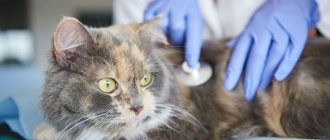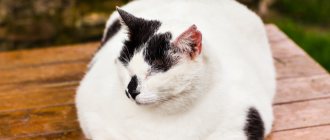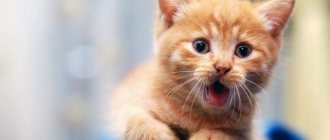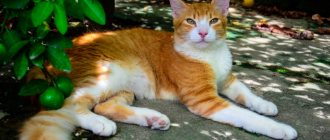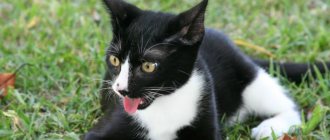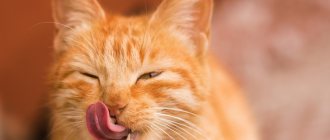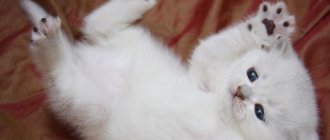Breathing is life. This is one of the reasons why cats and dogs with respiratory failure require quick and effective treatment. Experts at the Berloga veterinary clinic talk about what pulmonary failure is in animals, what symptoms it is accompanied by, and how therapy occurs.
Read in this article:
What is this?
Causes of pulmonary failure
How does DN manifest itself in cats and dogs?
When to ask for help?
How is respiratory failure treated in dogs and cats?
Initial stabilization
Diagnostics
Therapy
What is this?
Respiratory failure (RF) in dogs and cats is a pathological condition in which the animal’s lungs do not provide normal blood gas composition or do, but it is achieved due to the intensive work of the external respiratory apparatus and heart, which reduces the functional characteristics of the body.
Important! Pulmonary insufficiency in cats and dogs is dangerous because without timely treatment it leads to acute and chronic diseases of the bronchopulmonary system, circulatory disorders, damage to the central nervous system and a number of other dangerous complications.
Reasons to urgently consult a doctor
A cat's breathing itself is often not always a cause for panic. As noted above, the animal could get scared, angry, tired during outdoor games, etc.
Various chronic or infectious diseases that the owner knows about can cause such a symptom, then the cat is simply treated with methods previously prescribed by the doctor. However, there are accompanying signs when you need to take your pet to the clinic urgently :
- rapid or too weak pulse;
- change in color of mucous membranes (red, blue, white shades);
- severe wheezing or gurgling in the chest;
- copious amounts of fluid coming from the mouth or nasal passages.
Also, you should not hesitate if the indicated symptoms are absent, but the owner does not even imagine why his cat may often breathe from his stomach. The sooner a doctor makes a diagnosis, the higher the chances of a favorable outcome.
Causes of pulmonary failure
Any disturbance in the functioning of one or more respiratory organs (for example, the respiratory tract or lungs) can lead to the development of respiratory failure in a cat or dog, which poses a direct threat to the health and life of the animal.
Respiratory failure occurs when the level of oxygen in the blood becomes too low (hypoxemic form) and when the level of carbon dioxide in the blood becomes too high (hypercapnic form).
Important! The causes of hypoxemic (pulmonary) and hypercapnic (ventilatory) forms of respiratory failure in dogs and cats differ.
Causes of hypercapnic (ventilation) form of respiratory failure:
- Violation of central regulation of breathing (control of respiratory muscles). Such disorders occur with arterial hypotension (low blood pressure), as well as with pathological processes occurring in the central nervous system (for example, meningoencephalitis), traumatic brain injury and poisoning with drugs that suppress the functioning of the respiratory center.
- Neuromuscular disorders. The main feature of such diseases is muscle weakness. Respiratory failure in cats and dogs can occur against the background of myopathy (chronic progressive neuromuscular diseases), as well as ruptures or unilateral persistent high position of the diaphragm, accompanied by damage to the phrenic nerve in animals.
- Damage to the chest and pleural cavity. The causes of respiratory failure in dogs and cats can be pneumothorax (accumulation of air or gases in the pleural cavity), floating rib fractures, neoplasms (malignant and benign tumors), as well as foreign objects trapped in the chest, and even metastatic pleurisy (inflammation of the pleura) .
- Airway obstruction. Respiratory failure in dogs and cats can be caused by bronchial asthma, laryngeal edema, as well as narrowing of the lumen of small bronchi and bronchioles (bronchospasm). These diseases impair the animal's airways, which can lead to the development of respiratory failure.
Causes of hypoxemic (pulmonary) respiratory failure, when the oxygen level in an animal's blood becomes too low, include pneumonia, acute respiratory distress syndrome, pulmonary edema, as well as lung injury in cats and dogs, pulmonary fibrosis, and pulmonary thromboembolism.
Causes of lung diseases
Often the cause of the disease is bacteria that live in large quantities in the cat's throat, nose and lungs. They usually do not harm the host. Infection occurs when the body is weakened (for example, by rhinotracheitis or calicivirus) and the immune system is reduced. Read more about rhinotracheitis: Symptoms and treatment of rhinotracheitis in cats
The development of diseases is also caused by: - stress; — viruses; - toxic substances inhaled by cats; — injuries (when the ribs are fractured, their fragments pinch the lungs and do not allow the animal to breathe normally); - hypothermia; - lack of vitamins; - food that is too cold or frozen; - foreign objects in the respiratory tract.
Writer Oliver Hereward said that a cat is a tiny lion that loves mice, hates dogs and protects humans. Unfortunately, man himself often harms his pet lion from its very childhood. For example, smoking indoors increases the risk of developing lung diseases in a kitten, as it inhales nicotine vapors, which have a detrimental effect on the body. Murkoshi employees advise, if possible, to smoke outside the apartment (on the balcony). In addition to the fact that harmful substances enter the pet’s respiratory system, their resins settle on its fur. During washing, they enter the body and become heated, causing various diseases.
There are also congenital pathologies that cause difficulty breathing and lead to diseases of the respiratory tract and lungs: - narrowed nostrils; - lengthening of the soft palate; - cleft palate; - narrowing of the trachea.
How does DN manifest itself in cats and dogs?
Respiratory failure in cats and dogs occurs in acute or chronic form. In the first case, all symptoms rapidly increase within a few minutes or hours, and the condition itself poses a real threat to the life of the animal; in the second, all signs develop gradually.
The main signs of pulmonary failure in cats and dogs:
- apathy,
- decreased activity
- refusal of games and physical activity,
- loss of appetite,
- dyspnea,
- cyanosis of the mucous membranes of the oral cavity,
- rapid heartbeat (tachycardia),
- wheezing in the lung tissue (wheezing sounds when breathing),
- cough,
- shallow, asynchronous breathing,
- severe anxiety, anxiety.
Important! In severe forms of pulmonary failure in cats and dogs, white foam may be released from the mouth and nose, heart rhythm disturbances, hypoxemic coma and death may occur.
When to ask for help?
In case of acute respiratory failure, emergency veterinary care is important. Not only the health, but also the life of your pet depends on how quickly you contact a veterinarian in Moscow. If you notice increasing shortness of breath, coughing, wheezing, or difficulty breathing in a cat or dog, do not hesitate - make an appointment with a veterinarian.
Breathing Features of Cats
The breathing process of a cat is not fundamentally different from other mammals, including humans. When an animal breathes, air is drawn in through the nose, enters the larynx, and from there through the trachea is sent to the lungs. Next, oxygen is picked up by the blood and distributed to all organs of the body. "Waste" goes back along the same path:
In a calm state, a cat breathes approximately 30 times per minute, that is, every two seconds. The norm is the number of breaths from 20 to 40. In kittens this figure is slightly different and can reach 50 times.
Rapid breathing in adult cats is observed when they are frightened, excited, or angry about something. For example, while traveling in public transport, meeting a dog or during active games. You can also notice that the pet is breathing frequently and its stomach is heaving if the cat is very hot.
Another reason for deviation is the female’s prenatal condition or estrus. All these situations can be considered a variant of the norm. Very little time passes, the cat calms down and breathes as usual again. However, sometimes we are talking about deviations.
How is respiratory failure treated in dogs and cats?
Treatment of pulmonary failure in animals is a complex process. It includes several stages, the first is stabilization of the patient’s condition, the second is diagnosis, the third is direct treatment of respiratory failure. To make it more convenient for you to understand how treatment occurs, let’s talk separately about each of these stages.
Initial stabilization
It is necessary to stabilize the animal’s condition, prevent the development of complications and give the veterinarian time to diagnose. Initial stabilization usually includes:
- Oxygen therapy. It is performed with or without sedation. The most common approach is to use an oxygen cage with a high proportion of inspired oxygen (eg, 40-60%). Additionally, the veterinarian may use a face mask or oxygen hose. In extreme cases, cats and dogs require emergency intubation as well as a higher proportion of inspired oxygen (eg, 100%).
- Sedation. It is used in conjunction with intubation and ventilation if the pet is experiencing severe anxiety. Some animals, particularly dogs with upper airway obstruction, require stabilization with special sedatives. After their introduction, the veterinarian clears the animal's mouth of any obstructing material (for example, secretions), and then performs intubation or tracheostomy.
- Decrease in temperature. An increased respiratory rate often leads to hyperthermia, so cooling the animal is one of the stages of initial stabilization. To do this, cover the cat or dog with damp towels, use fans, and apply alcohol to the armpits, groin area, and feet. The decrease in temperature stops as soon as the temperature reaches 38 ° C in order to prevent the opposite effect - hypothermia.
Diagnostics
To make an accurate diagnosis, doctors at a veterinary clinic in Moscow assess whether the pet has a natural predisposition to upper respiratory tract obstruction (for example, English bulldogs have a predisposition to brachycephalic respiratory tract diseases), cardiogenic pulmonary edema, as well as lower respiratory tract obstruction caused by asthma.
The next stage of diagnosis is collecting an anamnesis. The doctor asks several questions of the pet owner to determine possible causes of pulmonary insufficiency (for example, blunt trauma to the dog reported by the owner may cause pulmonary contusions or pneumothorax, which are symptoms of pulmonary insufficiency).
Next, a clinical examination is carried out, and after the cat or dog’s condition is restored, an extensive diagnosis is carried out:
- blood analysis,
- Ultrasound, CT scan of the chest,
- echocardiography (ECG),
- respiratory tract examination,
- respiratory fluid analysis.
Therapy
Treatment depends on the diagnosis, which determines the cause of chronic or acute respiratory failure in cats and dogs. For example, if it is caused by lower airway obstruction due to mucus buildup or bronchial inflammation, treatment would include bronchodilators and corticosteroids and, if necessary, deworming.
If respiratory failure is caused by pneumonia, pulmonary edema or other pulmonary parenchymal diseases, treatment involves the use of broad-spectrum antibiotics. If the cause is pulmonary thromboembolism, then therapy includes taking anticoagulants and antiplatelet agents.
Remember that effective treatment of pulmonary insufficiency in cats and dogs is only possible with timely access to a veterinary clinic. The specialist will urgently take measures for initial stabilization, accurate diagnosis and treatment, the methods of which directly depend on the cause of respiratory failure.
Symptoms and diagnosis
Depending on the causes of the disease. In addition to cough, the following additional symptoms develop:
- dyspnea;
- refusal to eat;
- salivation;
- elevated temperature.
The veterinarian examines the animal, identifies clinical symptoms, collects anamnesis, and takes blood samples for general analysis and biochemistry. If necessary, additional diagnostic studies are carried out:
- stool analysis;
- study of tracheal washings;
- X-ray of the chest cavity.
The doctor deciphers the research results and develops a treatment strategy.
When fast breathing is normal
The normal breathing rate for a cat is 20-30 breaths per minute. In this case, slight deviations in both directions are possible. For example, a cat that inhales up to 35 times per minute, in the absence of other symptoms indicating illness, is completely healthy.
It is normal to inhale more frequently after physical activity and during hot weather. This is how the body tries to cool down.
During times of fear or stress, a cat's breathing may also become faster.
In the article I talked about respiratory dysfunction in cats. She listed its signs and possible causes. Describes cases in which changes in inhalation are normal and those in which urgent veterinary attention is needed, including signs that are similar in young kittens.
When heavy breathing is normal
It is incorrect to say that if a cat is breathing heavily, then some illness is to blame. So, our pets usually breathe heavily in the following cases:
- Fatigue
after active games or a long run;
Aggression
in relation to another unfriendly cat that is nearby;
Fear
(an animal may be frightened, for example, by the noise of a new vacuum cleaner, the roar of a gunshot, a trip in a car, etc.);
Estrus period and sexual heat
;
Pregnancy and lambing
(and even after giving birth, the cat can breathe heavily while feeding the kittens);
What examinations will be required?
To understand what causes rapid breathing in a cat, the veterinarian will question the owner in detail about when and under what circumstances the symptom appeared, what the animal ate the day before, whether it could have been poisoned, etc. Next, he will conduct a visual examination with palpation and, most likely, will refer you for tests.
In most cases, you have to donate blood and undergo ultrasound diagnostics. Sometimes an x-ray is required. These methods will help you find out why your cat is breathing frequently and prescribe adequate treatment.
When you look at how much your pet’s stomach swells and how often he gasps for air, it becomes truly scary. After all, breathing problems are a direct threat to life. However, there is no need to panic, although you also cannot waste time - you cannot get it back. If the condition worsens sharply, it will be more difficult to help the cat.
You should show the animal to a doctor as soon as possible and find out why it is breathing incorrectly. In the vast majority of cases, the diseases are not fatal and respond well to treatment.
Dangerous symptoms if a cat breathes with its belly
Sometimes, during difficulty breathing, the pet may experience pain. Externally, this manifests itself as the following signs:
- the cat looks excited and scared ;
- the muzzle is stretched out in an unusual grimace;
- pupils dilated;
- tail pressed to body;
- mustache pressed;
- the animal is aggressive .
Heavy belly breathing is a sign that your cat is not feeling well. It looks as if the pet is trying to inhale air with its stomach and push it out when exhaling. This type of breathing is called abdominal.
Normally, the abdominal muscles should not be used. When healthy, there is a vacuum in the sternum around the lungs. It allows the lungs to expand when inhaling.
In addition to belly breathing, lethargy, aggression and the inability to stand up are dangerous symptoms.
